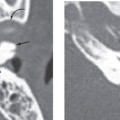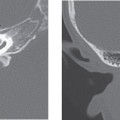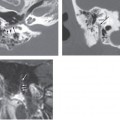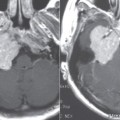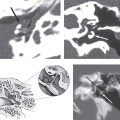CHAPTER 45 Epidermoid
Epidemiology
Epidermoid or congenital cholesteatoma is a congenital benign slow-growing lesion. It occurs commonly in the posterior fossa, with the majority of epidermoid cysts occurring in the cerebellopontine angle-internal auditory canal (CPA-IAC) and in the fourth ventricle. Epidermoid is the third most common CPA-IAC lesion, with acoustic schwannomas and meningiomas being most common. It represents 0.2 to 1.8% of all intracranial tumors. Epidermoid cysts usually present between 20 and 70 years of age, with peak presentation being at 40 years.
Clinical Features
Epidermoids are slow-growing lesions that may remain clinically silent for many years. The principal presenting symptom is dizziness. Patients may also present with other symptoms such as headache, trigeminal (tic douloureux) and facial (hemifacial spasm) neuralgia, tinnitus, or sensorineural hearing loss depending on the location and growth pattern. Malignant degeneration of an epidermoid cyst is an extremely rare occurrence.
Pathology
This is a developmental lesion arising from the inclusion of ectodermal epithelial elements at the time of neural tube closure during the 3rd to 5th week of embryonic life, resulting in migration abnormalities of epiblastic cells. On gross pathology the lesion is pearly white with lobulated cauliflower-shaped surface features. On microscopy the cyst wall consists of stratified squamous epithelium. It grows in successive layers by desquamation from the cyst wall. The cyst contents are made up of solid crystalline cholesterol and keratinaceous debris without the presence of hair follicles, sebaceous glands, and fat, which helps to differentiate it from a dermoid.
Treatment
Complete surgical removal is the treatment of choice. However, total excision may be difficult if the lesion abuts or surrounds adjacent nerves and vessels.
Imaging Findings
CT
These lesions typically are low attenuation. The margins may be well demarcated or have irregular or scalloped margins. A homogeneously low-attenuation epidermoid with well-defined margins may be difficult to differentiate from an arachnoid cyst. The presence of high attenuation with the cyst can suggest the correct diagnosis. Dense epidermoids have been described.
MRI
Stay updated, free articles. Join our Telegram channel

Full access? Get Clinical Tree


